
(Updated, 21 April, 2021)
On August 23, 2010, I posted about online learning and students with disabilities. In the post, I asked readers for suggestions about how to improve the accessibility of my own site and where people could find more information about standards for accessibility for the visually impaired.
I received an excellent response, both as comments to the blog and as private e-mails, and thought it might be useful to aggregate these into a single posting.
Resources
All About Vision has an excellent post on How to make the internet easier to navigate with impaired vision.
It covers how to:
- Utilize your device’s screen reader feature.
- Magnify the text on your screen, either as-needed or all the time.
- Control devices with your voice.
- Make internet text easier to read with features like high contrast, inverted colors and color filters.
- Change the size and speed of your mouse pointer.
- Remove distracting ads and images with a reader view.
Most of the tools referred to on this site are either free to download or already installed on a computer, laptop, cell phone or tablet.
Equal Access to Software and Information, EASI. This is a nonprofit organization which has been in existence for some fifteen years. Its president, Dr. Norman Coombs, professor emeritus of Rochester Institute of Technology in Rochester, is one of the most knowledgeable people about web accessibility. Unfortunately this site is no longer maintained because of health reasons, but many of the resources are still archived and these are accessible through this site.
Nvision Centre’s Internet Accessibility Guide provides a practical, clear overview of features for the visually impaired like screen readers and text adjustments. It also includes more advanced but popular options.
The Web Accessibility Initiative: http://www.w3.org/WAI/ Anne Pemberton commented though: ‘One problem with the W3C guidelines is that they presume all non-disabled users are text-centric and can do without images or illustrations. You need to make your own judgements on eliminating graphics.’
Joe Clark’s Best Practices in Online Captioning: http://joeclark.org/access/captioning/bpoc/
For checking the accessibility of a web site:
- AChecker: http://achecker.ca/checker/index.php
- WAVE: http://wave.webaim.org/
WordPress. Several people commented that WordPress has built in a number of the standards for accessibility so that posts are automatically accessible to the visually impaired. However, when posting in WordPress, it is important to follow certain guidelines which are given below under ‘Tips’. (I know a number of institutions, such as UBC, that are using WordPress as an online learning environment instead of an LMS for some courses.)
Blackboard Inc. announced on August 12 that the National Federation of the Blind (NFB) awarded Blackboard Learn(TM) its Nonvisual Accessibility Gold Certification, stating that the company’s software was the most accessible education application that the NFB had tested and making it the first and only learning management system to achieve certification. (I would be interested in any reader’s experience of Blackboard Learn’s accessibility for the visually impaired).
Moodle The U.K. Open University’s working group on accessibility has drafted specifications for the improvement of the accessibility of the Moodle course management system for version 1.7. Again, I would be interested in hearing from any reader willing to post their experiences of applying or using these specifications.
UBC has a Wiki on accessibility:
Freedom Scientific’s JAWS Reader works with a number of systems. JAWS reads aloud what’s on the screen.
Tips
1. The most common advice given when posting in WordPress was to use the alternate text box when loading images to provide a descriptor of the image and to label all graphics in simple, clear language
2. Second, overall design of the web site is critically important. Anne Parsons made the following comment:
web accessibility at its heart is how the site is organized as a whole. If it is logically laid out, if the links make sense, then it is truly accessible. On the other hand, there are web sites which observe all the basic rules for accessibility, but they are so badly laid out that they are frustrating to users. This has nothing to do with alt-tags or labeling graphics. If the page isn’t laid out logically, everyone will have trouble accessing it, not just the blind or visually impaired.
3. Use colours carefully to provide contrasts. Use a different colour from the text for hyperlinks, and also underline hyperlinks. Don’t use ‘click here’ but make make the hyperlinks short and self-explanatory (e.g. Equal Access to Software and Information)
4. Ann Parsons commented:
keep in mind that a person who is blind cannot see the screen as a whole, that is paramount when trying to understand how blind people use The Web. A sighted person sees a web page as an entire thing, a gestalt. A person who is blind has to navigate a new web site line by line and build the picture of the site in the mind. This is sometimes difficult, especially if the blind person does not have good visualization skills.
5. Use headings as much as possible to break up the page. This helps the user to know where they are.
6. Content: if you are using acronyms, try to provide the full definition as well.
7. Cindy Underhill notes:
the whole issue of dealing with media files is another challenge. To be truly accessible, a transcript should be provided. But, if you are embedding someone else’s video from YouTube (or another service) – most likely a transcript is not provided. Transcripting is fairly expensive.
I would add that good video will deliberately exploit the visual element, but there are problems with semantically converting the visual elements of video into words.
Comments
Despite all the efforts to improve accessibility to online learning for the visually impaired, there are still huge challenges, even allowing for the visually impaired being accustomed to huge challenges. Particularly where visual elements are critically important for learning, it may be necessary not just to follow accessibility standards, but to re-design specifically for the visually impaired.
Also, the situation in Canada is different from that in the USA. The USA has Federal legislation that requires educational institutions to take all reasonable steps to accommodate learners with visual impairment (although this legislation has yet to be tested for online courses). No such legislation exists at the federal level in Canada, although some provinces (e.g. Ontario) are considering similar legislation. This leaves it very much to individual institutions, and in particular to the professionals working in e-learning, to make sure that online courses and programs are as accessible as possible to people with visual and other challenges.
Lastly, this is an important area of knowledge in which I am not an expert. Thus if you have any other suggestions or comments to make on this topic, and other sites that can provide better information, please let me know.
See also: Moran, R. (2010) Blind advocates allege Penn State services not blind friendly Philadelphia Inquirer, November 13
Thanks
Many thanks to the following who contributed to this post:
Gary M. Lewis
Karen Elliott, Contact North
Anne Louise Pemberton, Educational Synthesis
Ann Parsons, Portal Tutoring
Natasha Boskic, External Programs and Learning Technologies, Faculty of Education, University of British Columbia
Cindy Underhill, Office of Learning Technologies, UBC









 Dr. Tony Bates is the author of eleven books in the field of online learning and distance education. He has provided consulting services specializing in training in the planning and management of online learning and distance education, working with over 40 organizations in 25 countries. Tony is a Research Associate with Contact North | Contact Nord, Ontario’s Distance Education & Training Network.
Dr. Tony Bates is the author of eleven books in the field of online learning and distance education. He has provided consulting services specializing in training in the planning and management of online learning and distance education, working with over 40 organizations in 25 countries. Tony is a Research Associate with Contact North | Contact Nord, Ontario’s Distance Education & Training Network.

